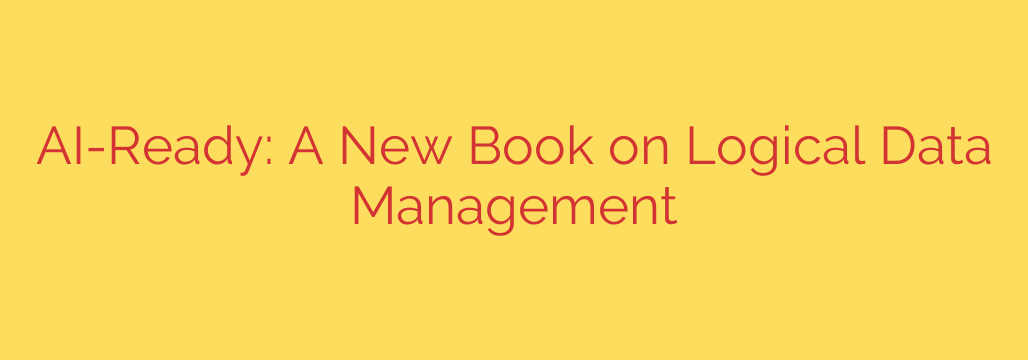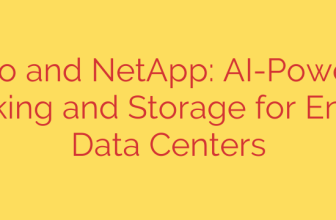
Unlocking AI’s Potential: Why Logical Data Management is Your Most Critical Strategy
Artificial Intelligence (AI) and Machine Learning (ML) are no longer futuristic concepts; they are critical drivers of business innovation and competitive advantage. Yet, a staggering number of AI projects fail to deliver on their promise. The reason is rarely the algorithm or the talent involved—it’s the data. Without a clean, accessible, and well-organized data foundation, even the most advanced AI models will falter.
The core of the problem lies in outdated data management practices. Many organizations still rely on physically moving and duplicating data into centralized repositories like data warehouses or lakes. This approach is slow, expensive, and creates complex, brittle data pipelines that are ill-suited for the dynamic needs of AI.
To truly become an “AI-ready” organization, a fundamental shift in thinking is required: a move from physical data management to logical data management.
The Hidden Barrier to AI Success: Disconnected Data
Before we explore the solution, it’s crucial to understand the problem. Traditional data infrastructure is often a patchwork of disconnected systems, applications, and databases. This leads to several critical challenges:
- Data Silos: Information is trapped in different departments and formats, making it nearly impossible to get a holistic view.
- Inconsistent Semantics: The same term, like “customer,” can mean different things in different systems, leading to confusion and inaccurate analysis.
- Slow Data Access: Data scientists can spend up to 80% of their time just finding, cleaning, and preparing data instead of building models.
- Poor Governance: With data copied and moved across the enterprise, it becomes difficult to enforce security, privacy, and compliance rules consistently.
AI algorithms are only as intelligent as the data they learn from. When fed with fragmented, inconsistent, and untrustworthy data, AI projects are destined for failure.
A New Paradigm: What is Logical Data Management?
Logical data management is an architectural approach that focuses on creating a unified, virtual data layer that provides access to all enterprise data without physically moving it. Think of it as a universal translator or a smart data map for your entire organization. It decouples the data consumption layer from the underlying physical storage systems.
This modern strategy is built on several key pillars:
- A Logical Data Fabric: This is an integrated architecture that weaves together all disparate data sources, providing a single, coherent view of your data landscape. It allows you to access, combine, and govern data in place, regardless of where it resides.
- Data Virtualization: This core technology allows applications to query and manipulate data from multiple sources as if it were in a single database. It provides real-time access to fresh data without the delays and costs associated with traditional ETL (Extract, Transform, Load) processes.
- A Unified Semantic Layer: This component provides business context to your data. By creating a common vocabulary and set of business rules, it ensures that everyone in the organization is speaking the same data language, from business analysts to data scientists.
By adopting a logical approach, you create an agile and flexible data foundation that can adapt to the ever-changing demands of AI and advanced analytics.
Actionable Steps to Build an AI-Ready Data Foundation
Transitioning to a logical data management strategy doesn’t have to be an overwhelming, multi-year project. You can achieve significant results by taking a pragmatic, step-by-step approach.
Map Your Data Landscape: Begin by identifying your key data sources and understanding how they are used. Create a comprehensive inventory of your data assets to understand where your most valuable information lives.
Define Your Business Vocabulary: Work with business stakeholders to create a common semantic model. Standardize key business terms and metrics to eliminate ambiguity and ensure consistency across all analyses and AI models.
Implement a Data Virtualization Platform: This is the technological heart of a logical architecture. Invest in a platform that can connect to your diverse data sources (databases, cloud applications, data lakes) and expose them through a unified, virtual layer.
Establish Centralized Governance: A logical approach makes governance easier, not harder. Use the virtual layer to enforce security, privacy, and access control policies centrally, ensuring that rules are applied consistently no matter how the data is consumed.
Start with a High-Value Use Case: Instead of a “big bang” approach, pilot your logical data fabric on a specific, high-impact AI project. This allows you to demonstrate value quickly and build momentum for broader adoption.
The Future is Logical
The race to AI leadership won’t be won by the company with the most data, but by the one that can harness it most effectively. Clinging to outdated, physical data management methods is like trying to fuel a rocket ship with crude oil. It’s messy, inefficient, and will ultimately hold you back.
By embracing a logical data management strategy, you can break down data silos, accelerate insight delivery, and build the robust, agile foundation necessary for sustained AI success. It is the definitive step in moving your organization from being merely data-rich to becoming truly insight-driven.
Source: https://datacenternews.asia/story/new-book-explores-logical-data-management-for-ai-readiness








